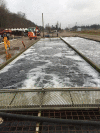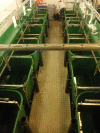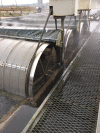Control of parasitic diseases in aquaculture
- PMID: 35950444
- PMCID: PMC10090776
- DOI: 10.1017/S0031182022001093
Control of parasitic diseases in aquaculture
Abstract
Finfish aquaculture in freshwater and marine environments is continuously expanding globally, and the potential for a substantial further increase is well documented. The industry is supplying fish products for human consumption to the same extent as capture fisheries, and new fish species for domestication are still being selected by the industry. The challenge faced by all aquacultured species, classical and novel, is the range of pathogens associated with each new fish type. A fish host in its natural environment carries a series of more or less specific parasites (specialists and generalists). Some of these show a marked ability to propagate in aquaculture settings. They may then elicit disease when infection intensities in the confined aquaculture environment reach high levels. In addition, the risk of transmission of parasites from aquaculture enterprises to wild fish stocks adds to the parasitic challenge. Control programmes of various kinds are needed and these may include chemotherapeutants and medicines as the farmer's first and convenient choice, but mechanical, biological, immunological and genetic control methods are available solutions. New methods are still to be developed by scrutinizing the life cycle of each particular parasite species and pin-pointing the vulnerable stage to be targeted. As parasites exhibit a huge potential for adaptation to environmental changes, one must realize that only one approach rarely is sufficient. The present work therefore elaborates on and advocates for implementation of integrated control strategies for diseases caused by protozoan and metazoan parasites.
Keywords: Aquaculture; control; disease; fish; parasite.
Conflict of interest statement
None.
Figures






Similar articles
-
A century of parasitology in fisheries and aquaculture.J Helminthol. 2023 Jan 12;97:e4. doi: 10.1017/S0022149X22000797. J Helminthol. 2023. PMID: 36631485 Review.
-
Metazoan Parasite Life Cycles: Significance for Fish Mariculture.Trends Parasitol. 2020 Dec;36(12):1002-1012. doi: 10.1016/j.pt.2020.07.011. Epub 2020 Aug 17. Trends Parasitol. 2020. PMID: 32819828 Review.
-
Parasitic diseases in marine cage culture--an example of experimental evolution of parasites?Int J Parasitol. 2007 May;37(6):581-8. doi: 10.1016/j.ijpara.2007.01.003. Epub 2007 Jan 18. Int J Parasitol. 2007. PMID: 17316650
-
Life in the fast lane: Temperature, density and host species impact survival and growth of the fish ectoparasite Argulus foliaceus.J Therm Biol. 2020 Aug;92:102687. doi: 10.1016/j.jtherbio.2020.102687. Epub 2020 Aug 14. J Therm Biol. 2020. PMID: 32888555
-
Advanced genomic research in understanding fish-borne zoonotic parasitic infection.Microb Pathog. 2025 Mar;200:107367. doi: 10.1016/j.micpath.2025.107367. Epub 2025 Feb 7. Microb Pathog. 2025. PMID: 39924092 Review.
Cited by
-
Fishing Innate Immune System Properties through the Transcriptomic Single-Cell Data of Teleostei.Biology (Basel). 2023 Dec 12;12(12):1516. doi: 10.3390/biology12121516. Biology (Basel). 2023. PMID: 38132342 Free PMC article. Review.
-
Zoonotic Agents in Farmed Fish: A Systematic Review from the Interdisciplinary Perspective of the One Health Concept.Vet Sci. 2025 May 2;12(5):437. doi: 10.3390/vetsci12050437. Vet Sci. 2025. PMID: 40431530 Free PMC article. Review.
-
Editorial: The immune evasion and survival mechanisms in aquatic organism infections.Front Cell Infect Microbiol. 2025 Jul 4;15:1648166. doi: 10.3389/fcimb.2025.1648166. eCollection 2025. Front Cell Infect Microbiol. 2025. PMID: 40689336 Free PMC article. No abstract available.
-
Conservation of parasites: A primer.Int J Parasitol Parasites Wildl. 2023 Jul 3;21:255-263. doi: 10.1016/j.ijppaw.2023.07.001. eCollection 2023 Aug. Int J Parasitol Parasites Wildl. 2023. PMID: 37483309 Free PMC article.
-
Greywater Reuse: Contaminant Profile, Health Implications, and Sustainable Solutions.Int J Environ Res Public Health. 2025 May 7;22(5):740. doi: 10.3390/ijerph22050740. Int J Environ Res Public Health. 2025. PMID: 40427856 Free PMC article. Review.
References
-
- Akhter N, Wu B, Memon AM and Mohsin M (2015) Probiotics and prebiotics associated with aquaculture: a review. Fish and Shellfish Immunology 45, 733–741. - PubMed
-
- Al-Jubury A, Lu C, Kania PW, Jørgensen LG, Liu Y, de Bruijn I, Raaijmakers J and Buchmann K (2018) Impact of Pseudomonas H6 surfactant on all external life cycle stages of the fish parasitic ciliate Ichthyophthirius multifiliis. Journal of Fish Diseases 41, 1147–1152. - PubMed
-
- Alderman D (1985) Malachite green – a review. Journal of Fish Diseases 8, 289–298.
-
- Alishahi M and Buchmann K (2006) Temperature-dependent protection against Ichthyophthirius multifiliis following immunisation of rainbow trout using live theronts. Diseases of Aquatic Organisms 72, 269–273. - PubMed
-
- Aslam ML, Robledo D, Krasnov A, Moghadam HK, Hillestad B, Houston RD, Baranski M, Boison S and Robinson NA (2020) Quantitative trait loci and genes associated with salmonid alphavirus load in Atlantic salmon: implications for pancreas disease resistance and tolerance. Scientific Reports 10, 1–15. - PMC - PubMed
Publication types
MeSH terms
LinkOut - more resources
Full Text Sources
Medical
Research Materials

